Thermaltake Muse R-Duo: External RAID
by Dave Robinet on December 14, 2007 2:00 AM EST- Posted in
- Storage
RAID Reconstruction
An integral (though often untested) part of a RAID controller is how well it handles unexpected events. Hard drives fail and errors occur, but the base requirement of RAID arrays that incorporate redundancy into their design is that the system remains up and running. In addition to uninterrupted system activity, the length of time that it takes a system to rebuild the array (i.e. return to a non-degraded status) can be a critical factor in ensuring that the dreaded "multiple drive failure" scenario doesn't occur. The Muse R-Duo has only limited options for what RAID flavors it will allow, and only one of these options (RAID 1) has any redundancy at all. Therefore, the RAID controller error handling and reconstruction tests will focus on RAID 1 mode.
Error Handling
While not a test measurable by a simple graph, we took the array and did our best to make it unavailable by forcing a variety of random tests (i.e. randomly disconnecting and reconnecting power and data cables). In a RAID 1 configuration, the controller - under ideal circumstances - should simply continue to allow data access to the existing "good" drive, immediately failing the second ("bad") drive and removing it from its configuration.
In this instance, the Muse R-Duo handled drive removal without issue. The blue and red lights flash on the front of the drive bay that is empty, indicating that the drive is dead. Replacing the drive, however, immediately brought the Thermaltake enclosure down - a soft "power off" state of sorts, rendering the data inaccessible to the OS - though powering the unit off and on showed that the data was still intact. The RAID 1 operation was therefore performed adequately, but the puzzling behavior of the unit when a drive was put into the slot (ostensibly to rebuild the array) could certainly be better.
One other nice thing to note is that the Muse R-Duo is intelligent about recognizing when a hard drive has truly failed. We performed the following as test:
- Power off the enclosure
- Remove the drive
- Power on the enclosure (enclosure realizes that the drive isn't available for use, and fails it)
- Power off the enclosure
- Re-insert the drive
- Power on the enclosure
The Muse R-Duo is smart enough to do a quick version check on the data to see that a rebuild isn't necessary. If any data is written to the array while one drive is not present, however, the Duo-R considers the replacement drive "fresh" and will rebuild the entire array. In those rare instances where a disk fails to spin up properly on the first attempt, however, it's nice to see that the Muse R-Duo will avoid unnecessary rebuild operations.
RAID Reconstruction
After failure of a disk, it is important that the user replace the dead disk with a new drive as quickly as possible. It is then equally important that the RAID controller rebuild the array swiftly and without issue, so that the array returns to a normal, fault-tolerant (non-degraded) state.
For this test, we ran a PCMark Vantage benchmark loop with the array in a "degraded" state after removing one of the drives from our RAID 1 array. After the benchmark successfully ran in this degraded state twice, we installed a new disk and instructed the array to rebuild. We re-ran the benchmark during this rebuild operation and looked at performance as well as the length of time required to rebuild the array under two conditions. First, as a worst-case scenario, we ran PCMark Vantage in a loop while allowing the array to rebuild. We then failed the array again and allowed the rebuild to occur under more or less "idle" circumstances for a best-case scenario. In this case, the Muse R-Duo does the rebuilding on its own with no connection to a host computer.

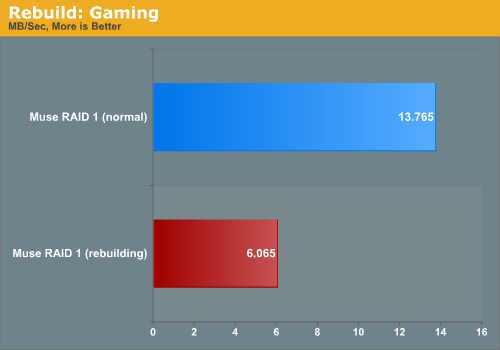
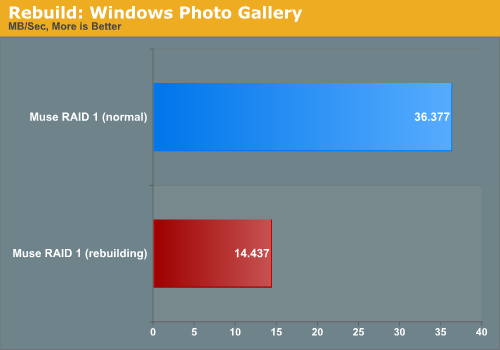

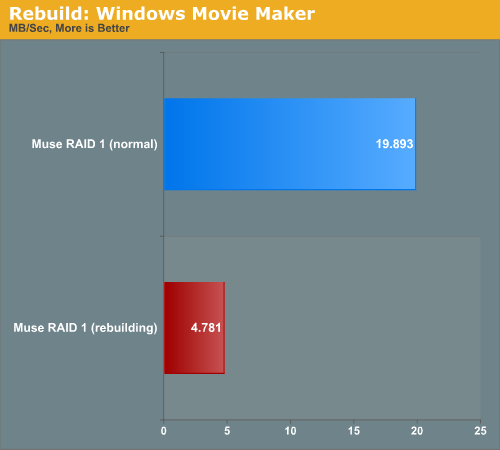
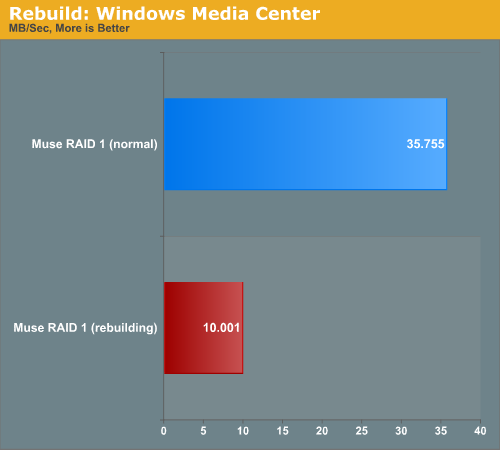
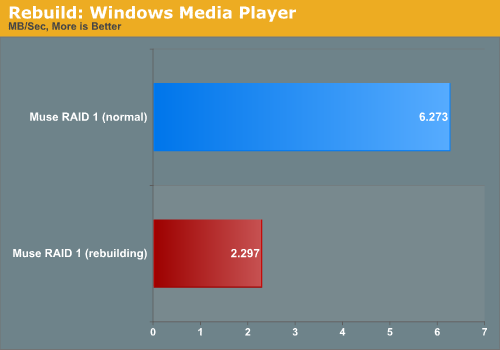
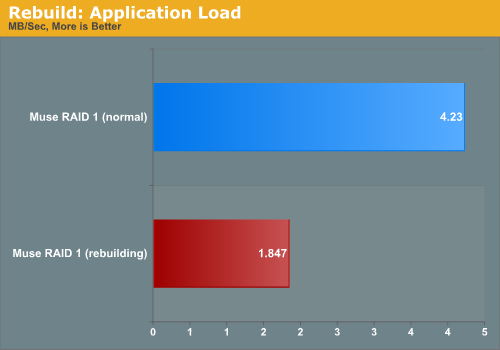
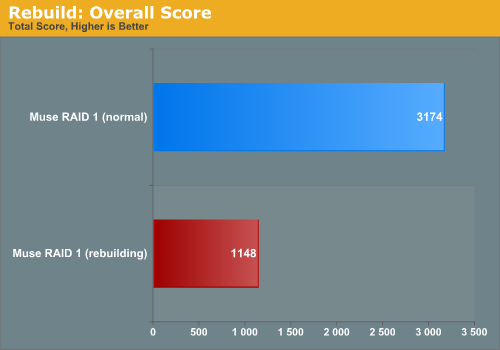
As expected, the Seagate slows to a crawl while the drive is busy reading data to restore the mirrored copy. As the number of RAID products we review grows, there will be a difference in the performance of the drive during rebuild. Remember, the performance and rebuild operation time are both important factors in a system relying on RAID for uptime. (For data retention, regular backups are necessary!) The rebuild operation took 6 hours and 54 minutes for a 1TB mirrored volume under ideal circumstances (detached from the host system). Under normal circumstances, however, where the host OS is going to be reading from and writing to the drive, the rebuild will take substantially longer.










11 Comments
View All Comments
Zak - Friday, December 14, 2007 - link
I've gone through 4 dual drive enclosures and concluded that anything with fan smaller than 80mm is too loud. They were usually louder than my computer so I don't expect this one to be any better. I've settled for SansDigital 4-drive USB eclosure in JBOD mode. Their 4-drive SATA is also a great value but I couldn't get the included SATA card to work properly neither under OSX nor Windows XP so it went back. But I'd like to see some reviews of SansDigital hardware, they have some nice offerings.Zak
MrPickins - Friday, December 14, 2007 - link
I'm sure I missed it when reading the article, but what type of connection were you using for the benchmarks?I'd assume eSATA, but I'd also like to see how the enclosure performs using the USB interface.
Dave Robinet - Friday, December 14, 2007 - link
Yep - eSATA was used. It's tough to imagine a lot of USB use for this sort of device, to be honest, so that wasn't tested.Thanks a lot for reading!
Magendanz - Friday, December 14, 2007 - link
I believe this unit uses the Silicon Image SiI5744 Storage Processor, which has frequent firmware updates and a decent utility called SteelVine Manager for configuring and monitoring the chipset. I purchased a similar unit called the ONNTO DataWhale from CoolDrives and have been very happy with it. (The DataWhale has removeable drive trays, which I like.)It's interesting to note that the SteelVine products have support for SAFE33 and SAFE50 modes (which split the drives into RAID 1 and BIG partitions) as well as an advanced GUI configuration mode that allows you to configure combined modes manually. On the DataWhale, this was enabled with an internal jumper and I'd expect the Muse also has this. Just pull the jumper and set the DIP switches to SAFE mode, then you can configure to your heart's content using SteelVine Manager.
Note: The latest version of SteelVine Manager requires the latest firmware update, but since SteelVine Manager is required to update the firmware this results in a bit of a Catch 22. Just install an older version of SteelVine Manager, install the firmware update, and then update to the latest version.
Yawgm0th - Friday, December 14, 2007 - link
The definition of RAID 1 listed in the article is not correct. In a standard RAID 1, the drives are mirrored and presented as a single volume to the operating system. However, they will both be accessed simultaneously during all read and write actions. This is why RAID 1 generally results in a substantial increase in read speeds but a slight decrease in write speeds.This is true if you are doing a software RAID, in which case the operating system or RAID software knows to do this, and with a hardware RAID, in which case the controller automatically reads and writes to both drives simultaneously. Anything else is not RAID 1.
The definition listed for RAID 1 in this article describes a behind-the-scenes backup, which is not RAID 1. If this is the case, it ought to be given more mention in the article. One of the biggest benefits to using RAID 1 is not just the high reliability, but the greatly increased read speeds. If the described method is what's in use, then it's a serious flaw in the device.
Dave Robinet - Friday, December 14, 2007 - link
The device does provide true RAID 1 in its normal sense. My choice of words was meant to illustrate the way the end-user sees the device, and it's substantially easier to say "show one device, then use the other".The reality of RAID 1 is that the OS reads from only one drive, so the basic definition is essentially true, though. I'll see about cleaning up the wording to satisfy both clarity and to make it more accurate. Good catch!
yyrkoon - Friday, December 14, 2007 - link
$143 usd is not a terribly large sum of money, but if you look into alternatives, you can get the addonics 2port port Multiplier, and do the same thing for cheaper. Then again, you'd have to either build your own enclosure, or buy one. I wouldnt be surprised if this device in fact uses the addonics port multiplier . . .All the above said, I would have to agree in wondering if RAID really has a place on the desktop(or most workstations and servers for that matter), as there are so many 'better' ways to store data safely without even using RAID in the first place. Database servers storing mission critical data MAY need RAID for an added form of reliability, but probably do not need RAID for performance, as any self respecting database admin is probably using a static ram HDD device, or possibly a large RAM disk(assuming balls out performance is even needed).
I cannot really help but wonder if a software RAID array, on a multiple core system would outperform this device or not. That and the fact with tools such as rsync, and just storing important files on multiple drives wouldn't be as safe, without the hassles/complications that RAID can bring into the big picture. The cost definately would be less . . .
cserwin - Friday, December 14, 2007 - link
I've had to explain to too many family members that their digital photos are gone-baby-gone because they haven't backed them up.I think RAID 1 is critical for digital photos.
ESATA give the advantage of allowing direct management of the photos on the redundant array without any appreciable loss of performance, and it is very portable for upgrades. It is way more functional than USB 'backup' solutions - especially for me, who gets the phone call when my uncle/mom/sister/aunt is having a problem.
yyrkoon - Saturday, December 15, 2007 - link
Sorry, but RAID 1 is not going to magically fix all of everyones problems. What happens if bobby-sue's kid deletes (a la shift delete) all their families image files, or disk corruption creeps onto a single somehow, while mirroring to the second ? Try explaining to a family that their Photos and other data files are bye-bye-gone after you recommended that they spend twice as much in HDDs plus controller(if needed).DeltaCopy:
http://www.aboutmyip.com/AboutMyXApp/DeltaCopy.jsp">http://www.aboutmyip.com/AboutMyXApp/DeltaCopy.jsp
Smart partitioning + DeltaCopy + offsite optical media storage may not be perfect, but is a good bit smarter than just adding another point of failure to a storage syst
Magendanz - Sunday, December 16, 2007 - link
Fortunately, Vista and Windows Server shadow copies prevents data loss in these scenarios.